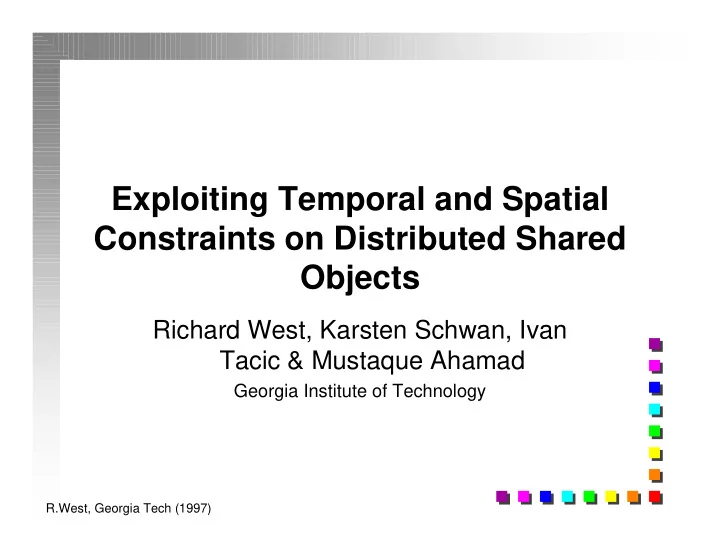

Exploiting Temporal and Spatial Constraints on Distributed Shared Objects Richard West, Karsten Schwan, Ivan Tacic & Mustaque Ahamad Georgia Institute of Technology R.West, Georgia Tech (1997)
Introduction ■ Distributed applications with shared state. ■ Existing consistency protocols developed primarily for scientific applications. ■ Better scalability & concurrency by exploiting application-level semantics. ■ Problem: How to formulate & use application semantics to efficiently share state. R.West, Georgia Tech (1997)
Approach ■ Aim to support applications exhibiting: ■ Poor and unpredictable locality. ■ Symmetric data access. ■ Dynamic changes in sharing behavior. ■ Data races. ■ Examples: ■ Multimedia video games. ■ Virtual environments. ■ Distributed interactive simulations. R.West, Georgia Tech (1997)
Contributions ■ Run-time support to efficiently maintain shared objects based on application semantics. ■ Development of S-DSO: ■ Semantic Distributed Shared Object System. ■ Support for applications with spatial / ordered constraints on shared objects. R.West, Georgia Tech (1997)
Overview ■ Sample application. ■ Semantics: ■ Definitions. ■ Temporal and spatial consistency. ■ S-DSO overview. ■ Experimental evaluation. ■ Results. ■ Conclusions . ■ Future work. R.West, Georgia Tech (1997)
Sample Application ■ Multi-player combat game with shared environment. ■ Derived from distributed interactive simulations. ■ Maneuver team of tanks to known goal in presence of enemies. ■ Exploit user-specified attributes to improve performance. R.West, Georgia Tech (1997)
Video Application R.West, Georgia Tech (1997)
Semantics ■ Application-level spatial & temporal semantics. ■ e.g. Exchange state info only when two tanks less than distance d apart. ■ Lookahead consistency: ■ Ability to predict future times when process groups must exchange object modifications. ■ Processes synchronize if/when object’s current state is required. R.West, Georgia Tech (1997)
Temporal and Spatial Consistency ■ Temporal ⇒ when changes to shared objects become visible. ■ Spatial ⇒ which processes should be updated with changes based on locations in shared space. ■ For any time interval τ n processes P i and P j only consistent for those objects needed in interval τ n+1 Process P1’s time-line τ1 τ2 τ3 τ n Time Synchronization points. [P2] [P2,P3,P5] Process group [P2,P4] involved in exchange. R.West, Georgia Tech (1997)
S-DSO: Semantic Distributed Shared Object System ■ s_functions : ■ Written by application programmer. ■ Used to dynamically determine: ■ which processes to send updates to when . ■ future synchronization times among process pairs. ■ exchange() function: ■ Internal to S-DSO. ■ Controls synchronous exchange of info. ■ Uses s_function to calculate when and which processes to send updates. R.West, Georgia Tech (1997)
S-DSO Overview Application s_func 1 s_func 2 s_func n Shared Objects Run-Time API Internal data structures System Messages to/from remote processes R.West, Georgia Tech (1997)
S-DSO Data Structures ■ Time-ordered list of (exchange-time, process) pairs. ■ Slotted buffer holding future exchanges with remote processes: R.West, Georgia Tech (1997)
Semantic-Based Consistency Protocols ■ Applied to our video game application. ■ BSYNC: ■ broadcast updates after every update and await replies. ■ concurrent (phased) exchanges every τ time units. ■ MSYNC: ■ Uses lookahead (s_function) ■ Synchronous exchanges based on position of process’ tanks. ■ MSYNC2 reduces unnecessary exchanges. R.West, Georgia Tech (1997)
S-DSO Experimental Evaluation ■ 16 SGI workstations, 10 Mbps ethernet, TCP ■ 2D shared environment (32x24 shared object blocks). ■ One tank per process - one process per processor. ■ Each tank tries to reach goal first. ■ Objects in N,S,E,W direction and range of tank’s location must be up-to-date. ■ Compare BSYNC, MSYNC against Entry Consistency. R.West, Georgia Tech (1997)
Time per Object Modification vs Number of Processes R.West, Georgia Tech (1997)
Number of Message Transfers as a Function of Number of Processes R.West, Georgia Tech (1997)
Number of Data Message Transfers vs Number of Processes R.West, Georgia Tech (1997)
Experimental Observations 1 ■ Entry Consistency exchanges fewer data messages. ■ Sends control messages to lock managers evenly distributed across nodes. ■ Suffers from blocking delays due to lock- acquisition. ■ Lookahead protocols couple synchronization with data exchanges. ■ Can send unnecessary updates to processes. R.West, Georgia Tech (1997)
Experimental Observations 2 ■ Lookahead consistency good for large numbers of fine-grained dynamically shared objects. ■ Efficient s_functions ensure synchronization with fewer processes at any time. ■ Problem with s_functions is how to avoid unnecessary exchanges. R.West, Georgia Tech (1997)
Conclusions ■ Implemented S(emantic)-DSO. ■ Supports application-specific consistency protocols. ■ Lookahead consistency can effectively meet needs of applications with: ■ Dynamic sharing behavior. ■ Data races. ■ Symmetric object accesses. ■ Assume ordered access or spatial relationships on objects. R.West, Georgia Tech (1997)
Future Work ■ Investigate use of graphs to represent relationships between objects. ■ n-dimensional object spaces: ■ Explicit relationship between object name and location in space. ■ Irregular object spaces: ■ Use graphs to capture: ■ Spatial relationships between objects. ■ Access-order to objects. ■ Consistency of meta-level graph information. R.West, Georgia Tech (1997)
Recommend
More recommend